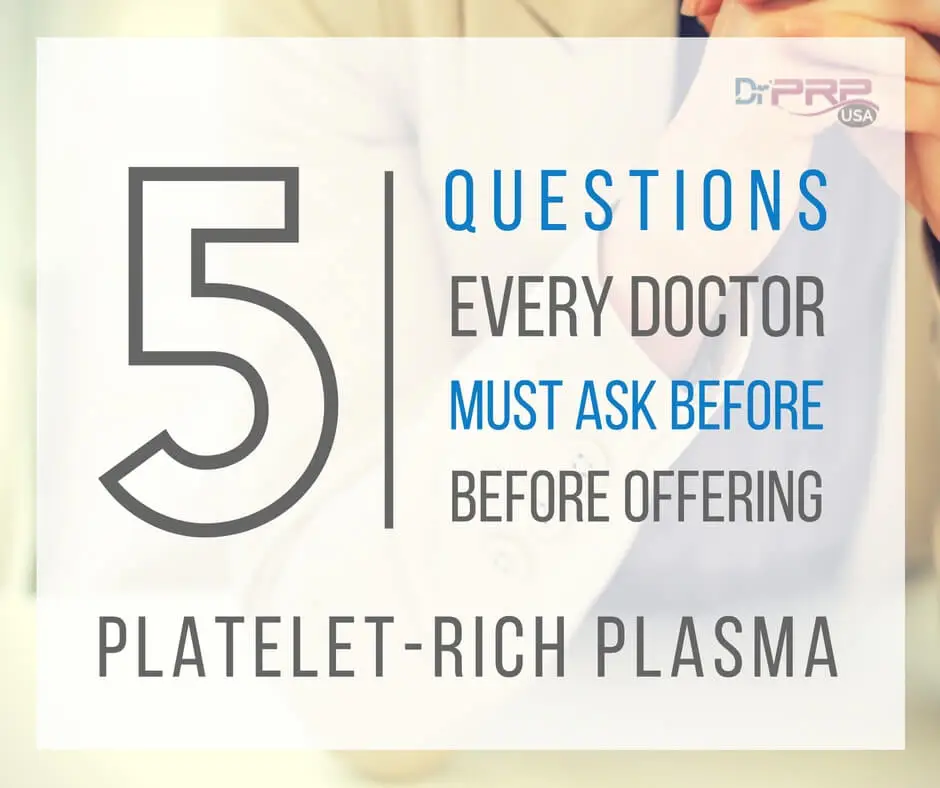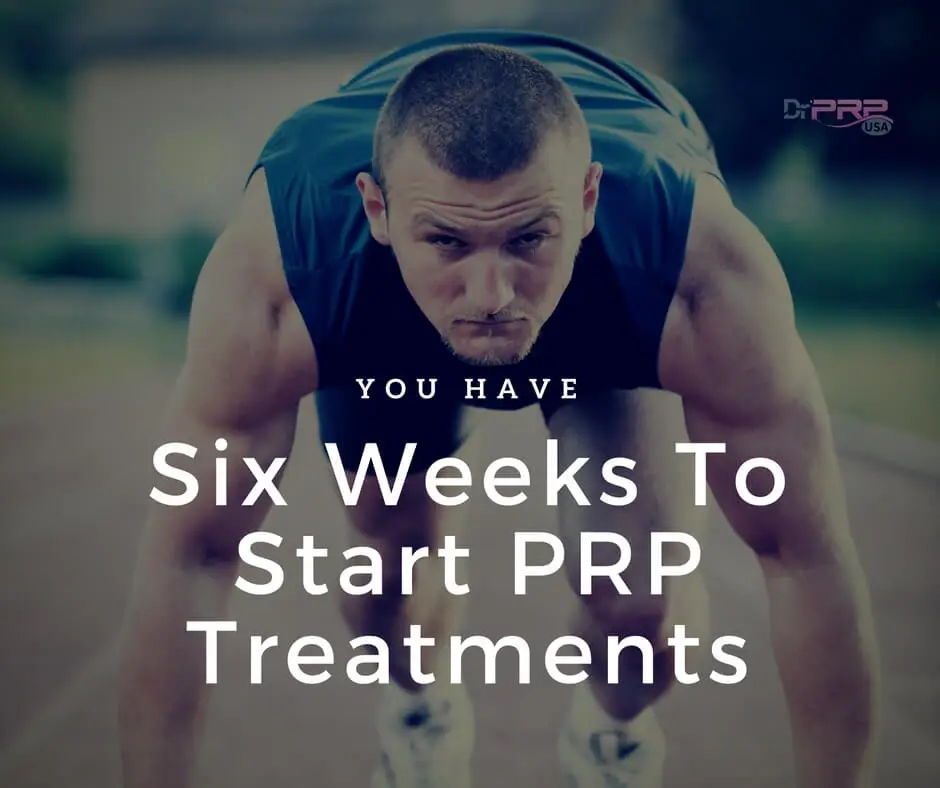| Item | Price | Qty | Total | |
|---|---|---|---|---|
 Loading Cart...
Loading Cart...5 Questions To Ask Before Offering Platelet-Rich Plasma

Almost everyone is an ideal candidate for Platelet-Rich Plasma.
PRP, with it’s more than 1 million platelets per microlitre constitution, has brought about huge relief for patients with acute joint injuries, joint pain, arthritis, torn meniscus sciatica, degenerative diseases, rotator cuff tears, ligamentous laxity… you name it. It is also injected into spinal discs for disk injection therapy, and into knee and shoulder joints for regenerative purposes.
Today, Platelet-Rich Plasma dominates fields like orthopedics, sports medicine, ophthalmology, wound healing and cosmetic enhancement.
That’s why there are 8,549 entries for Platelet-Rich Plasma in the NCBI databases. To give you a reference, acetaminophen, the #1 most prescribed drug, has about 19,741 entries.
Combining those with the fact that it’s autologous, and there’s little risk for rejection or side effects, it will seem like PRP is a universal healing agent.
Except it’s not.
There are a couple of things physicians must be careful of. Because there are times when administering PRP can be a bad decision although it’s not anywhere as complicated as a wrongly prescribed drug.

Here are the questions physician should ask before offering Platelet-Rich Plasma to their patients.
1. Are they free of these contraindicated conditions?
PRP happens to be one of the safest procedures out there. With PRP, you draw 20cc blood from the patient, spin it and then re-inject it to the injured area. No big deal. But as with any other injection, the basic risks of infection, pain and inflammation are still there. The blood collection, PRP processing, and activation should be done in a maximally sterile environment for the results to be accurate.
And that is if the patient is free of any of these pre-existing conditions:
- Cancer or Metastatic disease: the blood of patients with cancer, especially hematopoietic or of bone, might be infected with the cancer cells, so PRP is not advised. Same goes for any other metastatic diseases.
- An active local infection: if there’s an existing infection in the area to be treated, you must treat and heal the infections first before applying PRP therapy. Except for some bacterial infections which PRP’s anti-microbial properties can control.
- Pregnant or are breastfeeding: the risk of infection (even though minor) means it’s not advised for expecting or new moms.
- A low platelet count (thrombocytopenia): patients with platelet count less than 105/ul is not advisable since the low platelet count makes it ineffective anyway.
- Anemia or low HGB count: patients with less than 10 g/dl of hemoglobin should not be allowed to undergo PRP as their blood may be weak.
- Platelet dysfunction syndrome: patients with any of the five types of platelet function disorders are not recommended. It may aggravate their symptoms.
- Antiplatelet therapy: those who are undergoing antiplatelet therapy for arterial circulation may not see any results due to lack of platelets.
- Active Smoking Habit: smoking increases blood pressure and is said to lower platelets (not always), and so the effect of treatment may be low enough to not warrant it.
- Alcohol Overuse: we know consuming too much alcohol can diminish body’s capacity to release stem cells so alcohol intake should be controlled or avoided before and during Platelet-Rich Plasma treatments.
- Allergic to cows: bovine thrombin is typically the standard for initiating clotting of PRP and is derived from cows. So if the patients are allergic to cow’s products, alternatives need to be arranged.
- Septicemia or blood infection: if the blood is infected by harmful bacteria, its effects may be amplified by doing PRP.
- Local toxicity to Bupivacaine HCL or Lidocaine: if the patient has an allergic reaction or local toxicity to these, it could trigger an adverse reaction.
- Corticosteroid injection and NSAIDS: patients must refrain from taking any form of corticosteroid injections for up to ONE month prior to PRP therapy. As for NSAIDS like Nurofen, Voltaren or Mobic, that period is 7-10 days.
- Recent fever or illness: if the patient just recovered from a serious illness or fever, it may be advised to wait up to 60 days before having PRP treatment.
2. Is their condition treatable by Platelet-Rich Plasma?
First of all, the three vital factors in Platelet-Rich Plasma—growth factor levels, platelet count and activation times—will vary depending on the age and how healthy the patient is.
And so is the results. It varies from individual to individual.
Another factor to look at is the healing phase the patient is in.
Which Healing Phase Is Favorable For Platelet-Rich Plasma Treatments?
The basic mechanisms responsible for wound healing can be divided into three basic phases:
1) inflammatory
2) a proliferative phase, and
3) tissue remodeling (the longest phase).
The inflammatory phase begins immediately after a wound. This initial phase includes activation of fibrin from fibrinogen and development of a clot consisting of platelets and cross-linked fibrin strands. These platelets release a number of cytokines, growth factors and proteins that direct the wound healing.
The cytokines attract neutrophils and fibroblasts to the wound to direct the proliferative second phase of wound healing, and subsequently, attract fibroblasts which are crucial to the remodel or the third phase.
The earlier you can introduce Platelet-Rich Plasma, the stronger the effect it has on wound healing. The first two phases are obviously more favorable to the treatment because it is in those two early phases of wound healing that the cytokines and growth factors are much needed.
Which means, PRP is best administered less than 6 weeks after an acute injury before the healing slows or stops. In overuse or repetitive conditions, this time-period may be shorter.

That’s why we encourage physicians to use Platelet-Rich Plasma as the first-line treatment option for all healing purposes. Because, the treatment is best received in the early stages of osteoarthritis, and not only when all other options are exhausted. Our bodies naturally do that. Research shows that migration of platelets to the injured site is the first natural response of our bodies.
That being said, here are the common conditions that are known to have clinically proven benefits with Platelet-Rich Plasma treatment.
Conditions Which Can Be Treated By Platelet-Rich Plasma
Bone, Muscle And Tendon Regeneration:
If the patient’s condition will improve with bone, muscle or tendon regeneration, Platelet-Rich Plasma has a strong chance of helping. That’s why it is so popular among orthopedics. Almost all kinds of chronic tendon injuries, especially tennis elbow, Achilles Tendonitis, Rotator Cuff injuries, glenoid labral tears, hip labral tears, osteochondral lesions or inflammation of the knee patellar tendon will benefit from PRP. Even people with acute sports injuries like pulled hamstring muscles in the thigh and knee sprains benefit from it. Cartilage defects (CDs) and the most common joint disease, osteoarthritis (OA), are fantastic candidates.
And I believe every doctor has a duty to at least offer PRP to every patient suffering from these conditions, given that surgery is the only other option once conservative treatments fail.
We want to avoid surgery as much as possible.

Managing Healing, Recovery, and Pain:
PRP can accelerate healing and growth of bones, muscles, and tendons. So whenever there are large defects that need healing, a PRP injections can come in handy. This is true for healing after surgeries, recovery after chemotherapy, and general pain associated with age-related degeneration like back, knee and neck pain. PRP can also be used simply to improve the function of the shoulder, hip, and knees. PRP has also been used in spinal and joint fusion surgeries with success.
A skilled practitioner can administer numerous PRP injections (with varying constitutions, perhaps) depending on the severity of the condition.
Reducing aging, hair loss, and hormonal symptoms:
Platelet-Rich Plasma has become popular as a treatment for reversing aging symptoms in hands, face, neck, jawline, and décolleté including sagging jowls, thinning of the skin, puffiness, age spots, and wrinkling. Also, PRP is also considered a cosmetic medicine and is used to treat acne, scarring, eye bags, and post-pregnancy skin laxity.
The famous treatment is Platelet-Rich Plasma Facelift which is PRP combined with Micro Pigmentation where the PRP serum is directly injected into the skin through multiple tiny punctures under the dermis with or without topical local anesthesia. This stimulates the tissue and triggers a healing process; it’s the first step being a mild inflammation. The result is the production of new collagen tissues leading to a reduction of symptoms.
PRP has also shown promise to heal alopecia. It acts as fertilizer by recruiting stem cells to the hair follicles. PRP’s ability to form new blood vessels (angiogenesis) and the grow blood vessels from already-existing blood vessel tissues also helps.
Usage of Ultrasound Imaging
For PRP injections, the patient must also agree to use fluoroscopy, CT, or ultrasonography (US) for real-time visualization of the procedure. This maximizes efficacy by guiding the needle accurately.
3. Can the patient cover out-of-pocket costs?
Platelet-Rich Plasma is still considered experimental by most insurance companies (read more about insurance coverage for prp injections). Hence you may not be able to bill your patient’s health insurance plan for this service. However, if you’re a surgeon and use it in conjunction with surgery, PRP may be eligible for reimbursement. It’s best to ask the insurance company in advance.

Treatment cost can range from $200 to $2000 and in most cases patients have to bear it themselves. However, because there is no cost to actual PRP serum itself, the cost does not double or triple when more than one condition is treated. Typically the cost is calculated based on how much time it takes for the entire procedure.
Here are the insurance plans that do not cover PRP in general:
- AETNA
- BLUE CROSS BLUE SHIELD
- CIGNA HEALTH PLANS
- HEALTH NET
- UNITED HEALTHCARE
- MEDICARE (except when enrolled in a clinical study)
- OXFORD HEALTH PLANS
4. Do We Have The Right Protocol?
Although the Platelet-Rich Plasma procedure is simple as it looks from the outside, there’s more science to it that meets the eye. As the saying goes, the devil is in the details. And it can have a huge impact on the outcome.
Here are further questions to ask in this aspect.
Do we have the right concentration and composition? For the results with PRP to be consistent, you need the right concentration and composition. A higher platelet concentration may not necessarily be better and in some cases can be counterproductive.
How does leukocyte-rich and leukocyte-poor PRP compare? Do you know how leukocyte-rich and leukocyte-poor Platelet-Rich Plasma work for specific conditions? Leukocyte-rich PRP causes a more pronounced inflammatory effect than leukocyte-poor PRP and may be detrimental to the healing of tendons. Therefore, leukocyte-poor PRP is preferred for acutely injured tendons.
Which type of activation should we use? There are two types of activation that can release growth factors, endogenous or exogenous. But they both does not have the same results.
And which centrifuge and PRP system should we use? There are a lot of centrifuges and PRP systems in the market. It’s important that you know the criteria you need to pay attention to for the specific needs that you’ll be using PRP for.

5. Do We Have The Right Training?
As a physician, it’s your duty to be acutely aware of all the options you have with Platelet-Rich Plasma. And be able to determine the appropriate indication and contraindications for PRP use, consistent with ICMS/AMSSM standards. That’s why we suggest you attend a training course for extensive instructions.
Taking a proper course will also help you understand how to clearly communicate the risks, benefits, expected course, and follow-ups to the patient. This is assuming that as a physician, you already have a thorough understanding of graft selection and preparation of a graft with or without additive supports (calcium, thrombin, etc) as well as management of any complications.
Another important know-how that can come in handy for Platelet-Rich Plasma practitioners is pain management strategies.
Excellent Training On Platelet-Rich Plasma For Cosmetic Use
If you’ll be using Platelet-Rich Plasma for cosmetic purposes, here’s an excellent training that you can register for. It provides full training and CME credits for dermatological applications.

This Course also includes extensive Training on Using Micro Pigmentation along with PRP. Known as the PRP Facelift and the PRP Facial, these are hottest trends in the skin rejuvenation arena. You’ll also get the latest research on the subject with dozens of citations and live links to full-text peer-reviewed articles on this subject.
If you want a one-stop training to add cosmetic PRP to your existing practice of BTX-A and Facial Fillers… this is your best bet.
And the best part is everything is online. You can take the course at the comfort of your own home.



